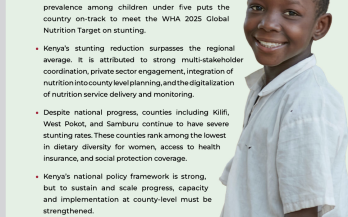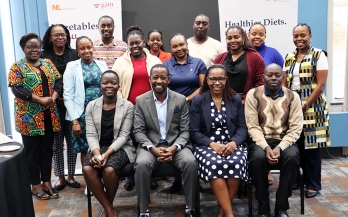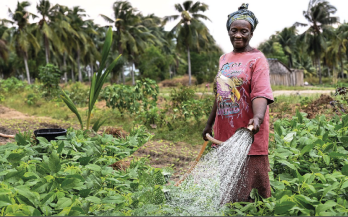


Harnessing Youth Potential For Transforming Tanzania’s Food Systems
- 11/10/2025
Youth in Tanzania are active at the community level but remain largely absent from formal governance. There is potential for Tanzanian youth to more actively help Tanzania in its ambition to achieve a nutrition-sensitive, climate resilient, inclusive food system.
Nourishing The Future: Improving Children’s Diets For A Healthier Ethiopia
- 11/10/2025
KEY MESSAGES Children in both urban and rural Ethiopia are increasingly consuming ultra-processed foods that contain unhealthy levels of sugar, salt, and unhealthy fats. These items, heavily marketed and widely accessible, are rapidly replacing traditional healthy diets. Inadequate and unhealthy diets during childhood can compromise physical and cognitive development, diminish immune function, and increase susceptibility to chronic illnesses later in life. Priority policy areas the government should consider include: more nutrition education; improved regulation of the food environment to make healthy options more prominent and unhealthy options less prominent; subsidies that prioritize healthy diets for children; and improved coordination and coherence across sectors seeking to transform food systems (e.g. Agriculture, Education, Health, and Trade). Reducing unhealthy diets in children is not just a nutrition issue – it’s a systems issue. Ethiopia must urgently implement a coordinated, multi-sectoral strategy with actions to ensure all children have access to diverse, healthy, safe, and affordable diets from the start of life.
Kenya’s Progress In Reducing Child Stunting
- 08/09/2025
Stunting is a major concern in Eastern Africa, where nearly 1 in 3 children under 5, about 22.6 million, are affected (UNICEF, WHO, Worldbank, 2023). In Kenya, the prevalence has declined to approximately one in five children (18%), outperforming the regional average of 31.6%. However, this still represents more than 1.2 million children at risk (KNBS, Ministry of Health, ICF, 2023). The consequences are far-reaching; stunting contributes to child mortality, vulnerability, and lifelong impairments in physical growth and cognitive development, impacting both individual well-being and national productivity. In Kenya, child undernutrition, including stunting as a key component, is estimated to cost the economy KES 374 billion (approximately USD 4.2 billion) annually, equivalent to 6.9% of the GDP (Government of Kenya, 2019). Stunting, a persistent form of long-term nutritional deprivation, acts as a silent driver of inequality, limiting opportunities, lowering future earnings and reducing the potential to contribute equally to the economy. Yet the returns on investment in nutrition are high, with every dollar yielding up to $22 in economic benefit. (Eberwein, et al., 2016)
Where Global Change Begins: Inside food markets and the important role city governments play
As we prepare for the 2025 Global Forum (13 – 17 October) marking ten years of the Milan Urban Food Policy Pact, we're bringing insights from our work across Africa and Asia on how city governments and local food markets can transform urban food environments and wider food systems. Walking through any bustling urban food market, from Pemba (Mozambique) to Arusha (Tanzania) and Bogor (Indonesia), is a remarkable experience. Beyond the offerings of fresh, dried, iced and frozen produce, spices, cooked traditional meals, and animated negotiations between vendors and customers, the experience of the market is at the nexus of food systems and nutrition policies and daily realities. These markets are about more than selling and buying food; they are where the future of food systems, within cities and across urban–rural landscapes, borders, and territories, is being lived, innovated, and imagined.
Business Engagement at UNFSS+4: The Experience of GAIN supported MSMEs
The Second United Nations Food Systems Summit Stock take (UNFSS +4) which held 27–29 July 2025 in Addis Ababa, co‑hosted by Ethiopia and Italy – closed with a powerful reaffirmation of political will, partnership, and accountability in support of sustainable, inclusive, and resilient global food systems transformation. It brought together 3,500+ participants, 145+ national delegations and 700+ non-state actors. Participants from governments, civil society, producers, youth, Indigenous Peoples, academia, and the private sector gathered for Plenary sessions, High-level Panels, Ministerial Roundtables, Investment Dialogues, and Stakeholder-led constituencies.
Business Engagement at UNFSS+4: The Experience of GAIN supported MSMEs (Interview with Max)
The Second United Nations Food Systems Summit Stock take (UNFSS +4) which held 27–29 July 2025 in Addis Ababa, co‑hosted by Ethiopia and Italy – closed with a powerful reaffirmation of political will, partnership, and accountability in support of sustainable, inclusive, and resilient global food systems transformation. It brought together 3,500+ participants, 145+ national delegations and 700+ non-state actors. Participants from governments, civil society, producers, youth, Indigenous Peoples, academia, and the private sector gathered for Plenary sessions, High-level Panels, Ministerial Roundtables, Investment Dialogues, and Stakeholder-led constituencies.
Media Urged to Champion Nutrition Agenda Amid Surge in Diet-related Non-Communicable Diseases (NCDs)
Senior editors and nutrition media champions met in Nairobi on Friday for a Media Roundtable on Nutrition Education and Advocacy, jointly hosted by the Ministry of Health and the Global Alliance for Improved Nutrition (GAIN) Kenya.
Mozambique: Nourishing rural markets with fresh and safe food supplies
Chimoio, Mozambique – A white Hino truck rattles under its own weight on the bumpy road, while its tires throwing particles of dust from the asphalt in the air from the district of Cantandica, Manica province, central Mozambique.
Rwanda Is Embracing A Food Systems Approach To Improved Prosperity
- 11/09/2025
While Rwanda has made notable progress in recent decades on areas linked to improved prosperity such as growth in agricultural production and poverty reduction,rates of malnutrition remain a public health concern, particularly among vulnerable groups like young children.